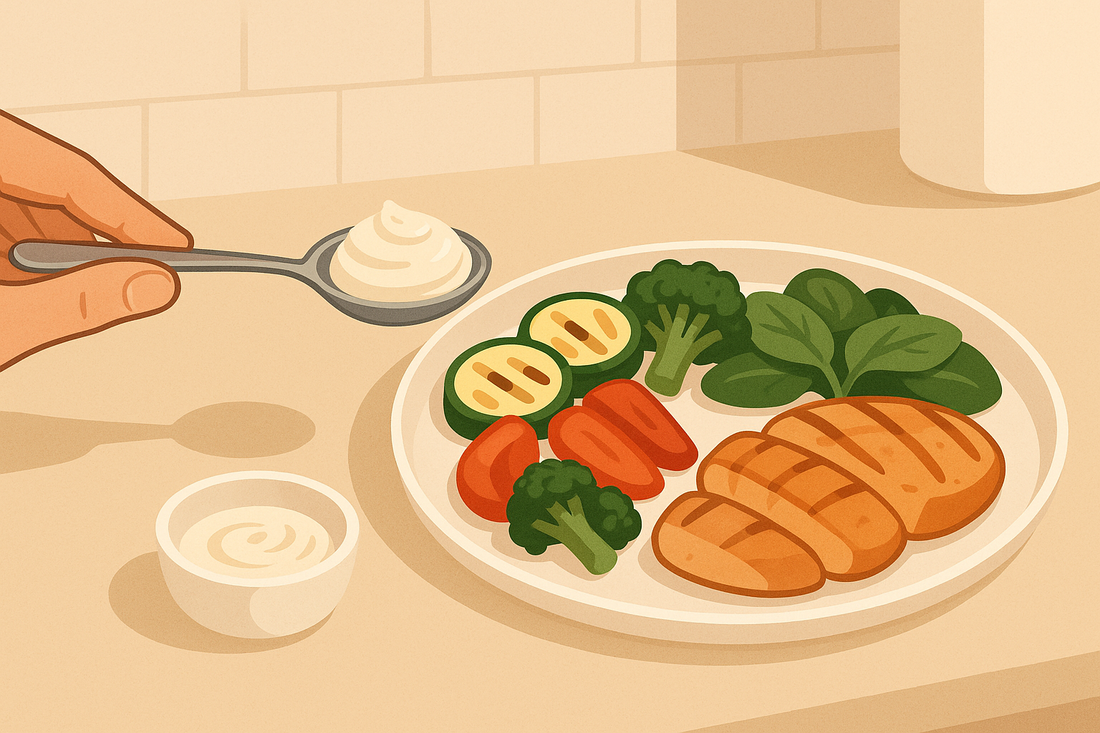
7 Tips for Portioning Sauces for Weight Loss
Share
Here's how you can enjoy flavorful sauces without overloading on calories:
- Measure Your Portions: Use tools like tablespoons, measuring cups, or a kitchen scale to control serving sizes.
- Pre-Portion for the Week: Divide sauces into small containers or ice cube trays to avoid overuse.
- Choose Low-Calorie Options: Opt for sauces with fewer calories, like those from Taste Flavor Co., which are 10 calories or less per serving.
- Marinate Instead of Topping: Let food soak in sauces before cooking to reduce the need for extra sauce later.
- Pair Smartly: Combine sauces with low-calorie foods like veggies, lean proteins, or salads.
- Control Dipping: Use small bowls, limit the amount per bite, and stick to a "one-dip rule."
- Create Custom Blends: Mix sauces for unique flavors but measure the final serving.
3 Healthy Homemade Sauces for Fat Loss (dairy free)
How Sauces Affect Your Daily Calories
Sauces can pack a surprising calorie punch, making it important to understand their impact on your daily intake. While they enhance the flavor of your meals, even small amounts can quickly add up. Here’s how you can keep those extra calories in check.
Calories in Common Sauces
Traditional sauces often come with a hefty calorie count. Luckily, there are lower-calorie alternatives that deliver great taste without overloading your diet.
Low-Calorie Sauce Choices
Taste Flavor Co. offers a range of sauces specifically crafted for those watching their calorie intake, with each serving containing 10 calories or less [1]. These sauces bring multiple benefits:
- Versatility: Perfect for marinades, seasonings, and condiments.
- Diet-Friendly: Gluten-free and keto-approved.
- Quality Ingredients: Made with real, wholesome components.
- Flavor Options: Includes Spicy Garlic Parm, Hot Honey Sriracha, and Cherry Smoked BBQ.
Up next, we’ll share seven practical tips to help you portion sauces effectively and keep your calorie goals on track.
7 Ways to Control Sauce Portions
You don't have to give up flavor to manage your sauce portions. These seven tips will help you enjoy tasty meals while keeping portions in check and supporting your weight loss goals.
1. Use Measuring Tools
Measuring tools make it easy to control portions. Keep these on hand:
- 1 tablespoon measuring spoon (0.5 oz) – Perfect for dressings.
- 1/4 cup measuring cup (2 oz) – Works well for marinades.
- A kitchen scale – For the most accurate measurements.
A tablespoon is often enough to enhance flavor without adding too many calories.
2. Pre-Portion Your Sauces
Save time and avoid overusing sauces by portioning them in advance. Use small containers or silicone ice cube trays to create single servings. This is especially helpful for meal prep, ensuring consistent portions throughout your week.
3. Choose Low-Calorie Sauces
Opt for sauces with fewer calories to help manage your daily intake. For instance, Taste Flavor Co. offers options like Spicy Garlic Parm and Hot Honey Sriracha, all at 10 calories or less per serving [1]. These can add bold flavor without derailing your goals.
4. Marinate Instead of Topping
Marinating is a great way to add flavor without using too much sauce. Let your food soak in the sauce for 30–60 minutes before cooking. This allows the flavors to infuse, reducing the need for extra sauce after cooking.
5. Pair with Low-Calorie Foods
Combine your sauces with lighter foods to keep your meals balanced. For example:
- Grilled veggies with a touch of Buffalo Blue Cheese sauce.
- Lean proteins paired with Sweet Honey Mustard.
- Fresh salads lightly dressed with Spicy Garlic Parm.
6. Manage Dipping Portions
If you're using sauces as dips, try these tips to avoid overindulging:
- Scoop a measured amount into a small bowl.
- Dip just the tip of your fork or skewer.
- Stick to a "one-dip rule" per bite.
7. Make Your Own Sauce Blends
Mix your own sauces for custom flavors while staying mindful of portions. For example, combine a bit of Cherry Smoked BBQ with a touch of Hot Honey Sriracha for a sweet and spicy kick. Just remember to measure your final serving to keep calories in check.
These simple strategies can help you control sauce portions without sacrificing taste in your meals.
sbb-itb-f97e3b5
Daily Meal Planning with Sauces
Plan Your Sauce Servings
Controlling calories starts with planning your sauce portions. Organize a daily schedule to allocate specific amounts for each meal:
- Breakfast: Use 1–2 tablespoons for eggs or proteins. For example, Taste Flavor Co's Sweet Honey Mustard has just 10 calories per serving [1].
- Lunch: Pack 2–3 tablespoons for salads, sandwiches, or grain bowls. Pre-measure portions into small containers if you're taking lunch to work.
- Dinner: Stick to 2–4 tablespoons. Distribute them wisely - 1–2 tablespoons for protein, 1 for veggies, and 1 for dipping.
Set aside 30 minutes every Sunday to pre-portion your sauces. This helps avoid accidental overuse and keeps your intake consistent. When you're away from home, use visual cues to stick to your planned portions.
Estimate Portions Without Measuring Tools
If you don’t have measuring tools handy, rely on these simple visual comparisons to gauge portions:
| Portion Size | Visual Reference | Common Uses |
|---|---|---|
| 1 tablespoon | Size of a poker chip | Dressings, dips |
| 2 tablespoons | Size of a golf ball | Marinades |
| 1/4 cup | Size of a tennis ball | Prepping for the week |
Helpful Portioning Tips:
- Use the center-of-your-plate method: divide your plate into quarters and limit sauces to one quarter.
- For dips, fill just the bottom of a small ramekin.
You can also create small "zones" on your plate specifically for sauces. This keeps the sauce from spreading across the entire plate or mixing with other ingredients, which can lead to using more than you intended.
Making Portion Control a Habit
Start Small and Build Gradually
Creating lasting habits takes time, so start small. Focus on one meal - dinner is a good choice - to practice controlling sauce portions.
Set up a dedicated sauce station with measuring tools and pre-portioned containers. Consider stocking low-calorie options like Taste Flavor Co's sauces, which are 10 calories or less per serving [1].
Here’s how to pre-portion your sauces for the week:
- Use small containers to measure out 1-2 tablespoon servings.
- Label each container with the date and serving size.
- Store these prepped portions at eye level in your refrigerator for easy access.
Once you’ve established a routine, keep track of your progress to strengthen the habit.
Track Your Progress
Keeping tabs on your sauce usage helps you stay on track. Here are some effective ways to monitor:
Digital Food Journal
Log your daily sauce portions alongside your meals. Include the type, amount, and total calories for each serving.
Weekly Check-In Table
Use a simple chart to track your progress, like this example:
| Day | Meals with Portioned Sauces | Total Sauce Servings | Stayed Within Plan? |
|---|---|---|---|
| Monday | Breakfast, Dinner | 3 tbsp | Yes |
| Wednesday | All meals | 5 tbsp | Yes |
| Friday | Lunch, Dinner | 4 tbsp | Yes |
| Weekend | All meals | 6 tbsp | No – adjust |
Other Progress Indicators
- Take weekly photos of your meals to visually track portion sizes.
- Record how you feel - energy levels, satisfaction, and any changes in weight - to measure your progress.
Summary
This guide covered practical tips for managing sauce portions without losing out on flavor. Keeping sauce portions in check can play a big role in supporting your weight loss efforts while still letting you enjoy delicious meals.
Opt for sauces that add flavor without piling on calories. Choosing lower-calorie options allows you to enhance your dishes while staying aligned with your goals. Combine this with mindful portion control, and you’ll have a reliable method to manage your intake.
Success comes from building lasting habits: measure your servings ahead of time, keep track of what you eat, pick lighter sauces, use them wisely, and regularly assess your progress. These steps help you enjoy the flavors you love while staying on course with your health objectives.
Even small adjustments to your sauce portions can make a noticeable difference over time. By consistently applying these strategies, you can seamlessly incorporate portion control into your daily eating habits.
FAQs
What are some simple ways to measure sauce portions without using kitchen tools?
Measuring sauce portions without kitchen tools can be easy with a few practical tricks. Use everyday items as visual guides - such as a tablespoon being roughly the size of your thumb (from the tip to the first joint) or a quarter cup resembling the size of a golf ball. You can also pour sauces onto a plate in small amounts and adjust based on your preference, keeping in mind that less is often more when managing portions.
Additionally, consider pre-measuring portions ahead of time and storing them in small containers. This makes it easier to control how much sauce you use during meals while staying aligned with your health goals.
How can I use low-calorie sauces to make meals flavorful while staying on track with my weight loss goals?
Using low-calorie sauces is a simple way to add flavor to your meals without adding extra calories. Taste Flavor Co. offers a variety of gourmet sauces, all 10 calories or less per serving, that are perfect for enhancing your dishes while supporting your health goals. These sauces are versatile and can be used as marinades, condiments, or seasonings.
Try drizzling options like Spicy Garlic Parm or Hot Honey Sriracha over grilled chicken, roasted vegetables, or rice bowls to elevate the flavor. You can also use Sweet Honey Mustard or Cherry Smoked BBQ as dips or spreads to make your meals more exciting without overindulging. With these sauces, you can enjoy bold, delicious flavors while staying mindful of your portion sizes and nutritional goals.
Why is pre-portioning sauces helpful for managing calorie intake over time?
Pre-portioning sauces is an effective way to manage calorie intake because it helps you control how much you're consuming with each meal. By measuring out your sauces in advance, you avoid accidentally overusing high-calorie condiments, which can add up quickly without you noticing.
This habit also makes it easier to stick to your weight management goals, as you can enjoy flavorful meals without the guesswork. For a guilt-free option, try low-calorie sauces like those from Taste Flavor Co, which are perfect for enhancing meals without exceeding your calorie targets.
